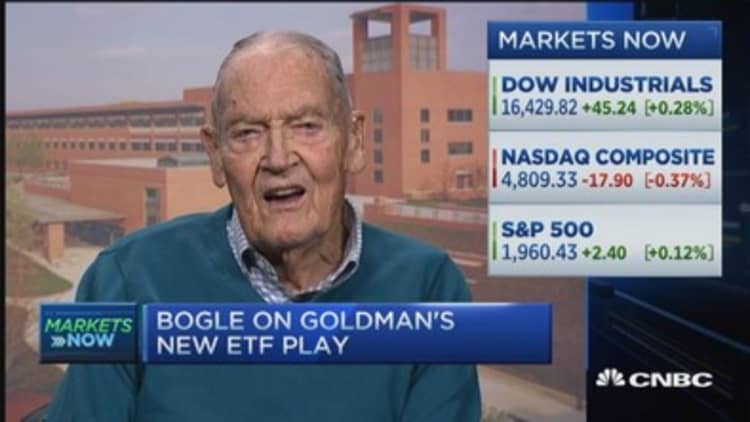



Many people over the years have asked Jack Bogle about his portfolio, hoping to divine the perfect investment mix. It's an especially pressing question now in a volatile market, in which international events are whipsawing stocks.
The founder of Vanguard Group, the world's largest mutual fund company, used to have a really basic portfolio that followed an asset allocation known as the 60-40 rule — 60 percent in a U.S. stock index fund and 40 percent in a U.S. bond index fund. He maintained that allocation for himself for years.
But he recently shifted his strategy by a hair: He's now at 50/50, which makes his portfolio slightly more conservative.
"I just like the idea of having an anchor to the windward," said Bogle, who is 86. "I'm not so much worried about having my estate grow."
Read MoreQuiz: Do you know how much fund fees can cost you?
The most obvious and important characteristic of what Bogle suggests is his advice to mirror the market through an index strategy instead of trying to beat the market. Research has borne out what looked controversial in 1974, when Bogle founded Vanguard.
"When you step back and look in aggregate, passive funds are winning by the cost of the fees," said John Rekenthaler, Chicago-based Morningstar's director of research. "This is Bogle's promise delivered."
The difference isn't huge — in most categories, passively managed funds outperformed by between 0.5 percent and a little over 1 percent — but it's clear. For instance, there were 562 actively managed funds in the U.S. large-growth category and 25 passively managed funds. In the 10 years leading up to Dec. 31, 2014, passively managed funds' asset-weighted return was an average 9.27 percent versus actively managed funds' 8.05 percent, according to Morningstar.
I just like the idea of having an anchor to the windward. I'm not so much worried about having my estate grow.Bogleon reducing his stock allocation 10 percent
If index investing is now the norm, other basics of Bogle's portfolio practices remain contrarian — and key to Bogle's designing a personal portfolio that he remains comfortable with over the long term.
Here are four ideas that have helped Bogle design the right portfolio for him, proving there's more than one way to challenge investment industry assumptions.
1. Bogle doesn't rebalance — if you must, once a year is enough.
Many investment advisors sell their services in part based on rebalancing or, in other words, selling your winners to return your portfolio to its asset allocation. Research shows you will reduce your risk of a big loss in the short term in your portfolio with regular rebalancing. But if you're really in your investments for the long term, even this level of tinkering may be more trouble than it's worth: You may end up with taxable gains, and you certainly will end up incurring trading costs. Bogle doesn't do it for his own portfolio.
"If you want to do it, once a year is probably enough," he said.
2. Bogle doesn't invest overseas — at least, not directly.
Bogle famously keeps his portfolio entirely in U.S. markets. This isn't because he's U.S.-centric: In fact, he pointed out the inconsistency of even calling the rest of the world "international." He just believes in placing bets based on what he knows, and "we have the best investor protections and legal institutions," he said.
Many large U.S. companies derive 50 percent or more of their revenue from outside the United States, so buying a fund comprising the U.S. market de facto gives you exposure to international markets. For instance, New York City-based Colgate-Palmolive had only 18 percent of its net sales in the North American market in 2014.
But Bogle's advice goes against conventional wisdom and even some Vanguard Group research. In 2014, Vanguard research suggested that investors allocate at least 20 percent of an equity allocation to non-U.S. stocks.
Tim McCarthy, former president of Charles Schwab and author of "The Safe Investor," agrees with Vanguard in this case, not Bogle.
"No matter how great a country is, putting zero outside your own country is the wrong answer on both a risk and return basis," said McCarthy by email. "Having a minority portion in international over the decades will decrease your risk and increase your returns."
3. To Bogle, diversification means bonds — and it doesn't need to mean anything more than that.
If you are perfectly comfortable with risk, you'd put your asset allocation into a 100 percent stock portfolio and keep it there until you die, because historically, that's the kind of asset that has produced the best returns over the longest period of time. But an all-equity portfolio in 2007–09 would have been a disaster, a point Bogle made in his book "Common Sense on Mutual Funds." Your portfolio would have recovered eventually, but what if you needed the money during that time span?
Bogle uses bonds to leaven equity risk in his portfolio. He's comfortable with a simple portfolio, increasing the bond allocation as he ages, because he wants to reduce the risk of a sudden, massive drop in value.
But you can also use funds that represent other asset classes to reduce volatility, like REITs, international stocks and international bonds. It's more complicated, but research suggests you will get some benefit in terms of reduced risk and, perhaps, higher returns.
4. Bogle believes that if you make the 'simple' portfolio choices, you'll spend a lot less time worrying.
The genius of Bogle's portfolio, for him, is its simplicity. It's easy for him to track and understand, and therefore stick to. You might like the challenge of trying to maximize your returns by adding diversification or rebalancing — just be sure you can stick to what you decided and won't sell in a panic or buy in greed. The fundamental thing you want from your portfolio is a sense that it's the right choice for you over the long term.
A plan that uses low-cost, diversified investments should take care of the other big risk in investing — emotions-based decision-making. For Bogle, being an investing master isn't about the exact makeup of his portfolio; it's about tailoring it to what feels right for him and sticking to it.
—By Elizabeth MacBride, special to CNBC.com




